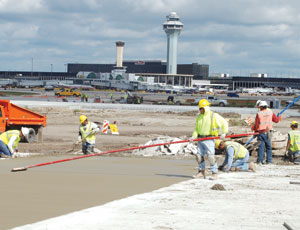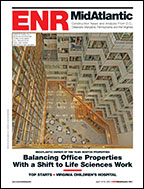The aviation industry has been hit by its share of turbulence in the past few years. Many airports had to defer projects or downsize capital improvement programs after revenue streams were curtailed sharply by upheaval in the airline industry, shaky credit markets, surging oil prices and decreased passenger travel.

Now, aviation officials say they are cautiously optimistic that the economy is stabilizing but that the recovery may be protracted.
“There is still a lot of uncertainty, but hopefully the worst part of the recession is over and these initial indicators that traffic levels are beginning to grow again will turn into meaningful trends,” says Chris Oswald, vice president of safety and technical operations for the Airports Council International-North America (ACI-NA). “The outlook isn’t as pessimistic as last year, but I don’t see a rash of large projects suddenly rolling out the door.”
Rapidly improving demand has pushed passenger traffic worldwide approximately 4% above the pre-crisis levels of early 2008, according to data from Montreal-based International Air Transport Association (IATA). The trade group expects passenger demand to grow 7.1% this year over 2009 and cargo traffic to expand 18.5% over the same period. However, passenger and cargo traffic are expected to shrink again in 2011.
“The industry recovery has been stronger and faster than anyone predicted, but a reality check is in order,” said Giovanni Bisignani, IATA’s director general and CEO. “There are lingering doubts about how long this cyclical upturn will last. As a result, 2011 is looking more austere.”
Despite the gloomy outlook, aviation officials are forging ahead with projects thanks to a combination of factors: the federal Airport Improvement Program and American Recovery and Reinvestment Act (ARRA) as well as the discovery of upsides to the economic downturn.
O’Hare International Airport in Chicago has completed two major runways and a new air traffic control tower, and now construction is under way on a third runway as part of its $8.8-billion modernization program. “We believe now is exactly the time to move forward on the O’Hare modernization program so that O’Hare is ready when air travel picks up,” said Chicago aviation commissioner Rosemarie Andolino.
The Chicago City Council recently approved $1 billion in bonds for the airport modernization program. Funding will be used primarily for runway projects scheduled to be bid between now and the end of 2011. The work includes runways, site preparation and utility projects.
Increased competition among contractors at O’Hare and other airports has been one positive outcome from the sluggish economy. “Just a few years ago, the O’Hare modernization program would often have only two to three bidders,” said Andolino. “We have recently had as many as nine bidders for similar projects resulting in more competition and lower bids.”
Low bids from increased competition also helped keep the Atlanta Hartsfield-Jackson International Airport’s $6-billion capital program within budget. “There weren’t many other opportunities at the time we were procuring contracts, so there was a lot of interest in our projects,” said Mike Williams, airport assistant director of project management. ATL’s new $1.2-billion, 1.2-million-sq-ft Maynard H. Jackson Jr. International Terminal topped out this spring and is on schedule to open in 2012.
In addition to low contract bids, another advantage for airports has been plentiful labor.
“While the general slump in the economy is unfortunate for all of us, a silver lining for the construction industry has been an abundance of highly skilled men and women in the many trades necessary to bring about the exceptional progress we have seen on all of our Terminal 3 projects,” said Jim Ryan, assistant director for construction and engineering for Clark County, Nev., Dept. of Aviation. At McCarran International Airport in Las Vegas, construction on the $2.4-billion, 1.9-million-sq-ft Terminal 3 project is 80% complete and remains on schedule to open in mid-2012. This fall, work continues on the building’s cable-tensioned glass curtain wall, exterior stone detailing, elevated departure roadway and interior walls, flooring and ceilings.
Although cheaper materials, competitive bids and plentiful labor are helping airports weather the stormy economy, such silver linings are not enough to entice some aviation officials into implementing new projects.
Mineta San Jose International Airport (SJC) is nearing completion on a $1.3-billion terminal-area improvement program that involved expanding an existing terminal to 338,000 sq ft and constructing a new 503,000-sq-ft terminal and concourse, a new 3,350-space consolidated rental-car and parking garage, and an improved roadway network. The projects are ahead of schedule, and the program is approximately $78 million under budget. But instead of putting the money towards a parking structure, which was previously cut from the program’s scope, SJC elected to hold off.
“Although it is highly desirable from an infrastructure perspective to add the [garage] project back in, we have to wait until the recession is over to move forward with capital improvements,” says Dave Maas, deputy director of aviation at SCJ. Maas adds that increases in either flights or passenger capacity will trigger future expansion plans.
At airports nationwide, construction of over 333 runway, taxiway, lighting and safety projects were made possible in the last year through $1.1 billion in ARRA grants. Because of low bids on ARRA projects, the Federal Aviation Administration funded five additional airport projects in September totaling $9 million.
Vermont’s Burlington International Airport, which previously received $5.6 million in stimulus funding for taxiway rehabilitation projects, received another $425,100 to construct a parallel runway connection at Taxiway J. “The ARRA grants were crucial [for] these necessary improvements, especially the initial grant for Taxiway C,” says Heather Kendrew, airport director of maintenance, engineering and environment.
With the distribution of ARRA grant money nearly complete and the Federal Aviation Administration Reauthorization Bill still pending, aviation officials are concerned about how to fund future capital improvements.
The ACI-NA estimates airports’ capital development needs for 2009 through 2013 to be $94.3 billion. “The stimulus funding was a nice shot in the arm, but without sustainable multiyear funding, it’s difficult for airports to plan effectively and not do stopgap construction programs,” says ACI-NA’s Oswald.


Post a comment to this article
Report Abusive Comment